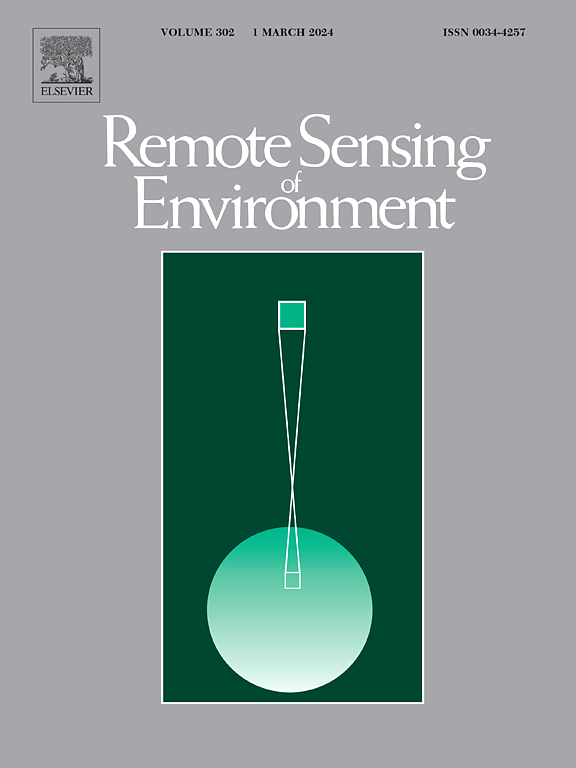Internal solitary waves in the Banda Sea, a pathway between Indian and Pacific oceans: Satellite observations and physics-AI hybrid forecasting
IF 11.1
1区 地球科学
Q1 ENVIRONMENTAL SCIENCES
引用次数: 0
Abstract
Internal solitary waves (ISW) are widespread in global oceans, and satellite/in-situ observations showed that the Banda Sea has frequent ISW activities, characterized by long-wave crests, fast propagation speeds, and large amplitudes exceeding 100 m. In this paper, we conducted a comprehensive ISW study in the Banda Sea to reveal ISW characteristics by collecting 417 synthetic aperture radar and optical images from 2013 to 2019. The constructed dataset comprises 134 pairs of matched satellite images and a total of 12,021 ISW propagation vectors were extracted. Satellite observation reveals that ISWs in the Banda Sea mainly originate from the Ombai Strait and propagate northward, with an average propagation speed of over 2.50 m/s and with seasonal variation of less than 20 %. To forecast ISW propagations, we developed a physics-informed neural network ISW forecast model combining the classic Eikonal Eq. (EE) and the data-driven AI algorithms following a two-step transfer learning scheme. The forecast model employs a three-hidden-layer structure with 512 nodes in each layer. Firstly, the hybrid model includes ISW physics by setting the EE as the loss function. The second step is the data-driven process, which exploits a fully connected neural network and collected ISW dataset to improve EE-based model performance by 61 % with a loss function of the mean squared error. Through the two-step training, the forecast model adopts ISW physics and also benefits from the high accuracy of the data-driven process. We randomly selected 188/118 satellite images from the built dataset to serve as the training/test dataset for the data-driven process. After the second-step training, the root mean square (average) error of the model-predicted ISW propagation time reduced from 2.59 (2.37) h to 1.01 (−0.01) h. Error analysis shows that the data-driven process can efficiently correct the systematic error in the first-step model, which stems from errors in determining the ISW source and the propagation speed distribution map. Using the developed model, we predicted the propagation time of the ISWs and compared these predictions with satellite observations and in-situ observations. The comparison showed a high degree of agreement regarding the ISWs' location and their wave crests' geometry between model predictions and satellite/in-situ observations. Key differences between the proposed model and previous models are discussed.
班达海的内部孤立波,印度洋和太平洋之间的通道:卫星观测和物理-人工智能混合预测
内孤立波(ISW)在全球海洋中广泛存在,卫星/原位观测表明,班达海内孤立波活动频繁,具有波峰长、传播速度快、振幅超过100 m的特点。本文通过收集2013 - 2019年417幅合成孔径雷达和光学图像,对班达海海域进行ISW综合研究,揭示ISW特征。构建的数据集包含134对匹配的卫星图像,共提取了12021个ISW传播向量。卫星观测显示,班达海isw主要发源于乌姆拜海峡,向北传播,平均传播速度在2.50 m/s以上,季节变化小于20%。为了预测ISW的传播,我们开发了一个基于物理的神经网络ISW预测模型,该模型结合了经典的Eikonal Eq. (EE)和数据驱动的AI算法,遵循两步迁移学习方案。预测模型采用三隐层结构,每层512个节点。首先,将EE作为损失函数,将ISW物理纳入混合模型;第二步是数据驱动过程,该过程利用全连接的神经网络和收集的ISW数据集,通过均方误差的损失函数将基于ee的模型性能提高61%。通过两步训练,预测模型采用了ISW物理,并受益于数据驱动过程的高精度。我们从构建的数据集中随机选择188/118张卫星图像作为数据驱动过程的训练/测试数据集。经过第二步训练后,模型预测的ISW传播时间的均方根误差从2.59 (2.37)h降至1.01(−0.01)h。误差分析表明,数据驱动过程可以有效地纠正第一步模型中由于确定ISW源和传播速度分布图错误而产生的系统误差。利用该模型预测了isw的传播时间,并与卫星观测和现场观测结果进行了比较。比较表明,模式预测和卫星/原位观测在isw的位置和波峰几何形状方面高度一致。讨论了所提出的模型与以前的模型之间的主要区别。
本文章由计算机程序翻译,如有差异,请以英文原文为准。
求助全文
约1分钟内获得全文
求助全文
来源期刊

Remote Sensing of Environment
环境科学-成像科学与照相技术
CiteScore
25.10
自引率
8.90%
发文量
455
审稿时长
53 days
期刊介绍:
Remote Sensing of Environment (RSE) serves the Earth observation community by disseminating results on the theory, science, applications, and technology that contribute to advancing the field of remote sensing. With a thoroughly interdisciplinary approach, RSE encompasses terrestrial, oceanic, and atmospheric sensing.
The journal emphasizes biophysical and quantitative approaches to remote sensing at local to global scales, covering a diverse range of applications and techniques.
RSE serves as a vital platform for the exchange of knowledge and advancements in the dynamic field of remote sensing.
 求助内容:
求助内容: 应助结果提醒方式:
应助结果提醒方式:


